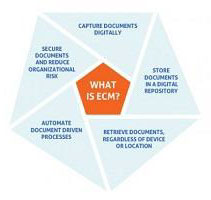
Enterprise Content Management is a systematic approach to managing content throughout its lifecycle. It enables unstructured information — such as Word documents, PDFs, emails and scanned images — to be securely stored and made accessible to authorized users.
From commercial supply chains to contract management, HR processes to government administration, the driving force behind implementing an ECM solution is to do business more efficiently. By eliminating dependence on paper documents and organizing unstructured information according to business needs, organizations can simplify and streamline work.
Goals for implementing ECM. Customers commonly rely on ECM to:
Here are 5 key elements of an ECM solution:

Top 5 Elements of ECM
1. Capture documents digitally
Managing an organization’s content begins with the capture and importing of information into a secure digital repository. This can be any kind of document that is created, captured, stored, shared or archived, including:
A few methods of capturing these documents include:
Traditional methods of capturing documents require a great deal of effort and expense. Capturing documents in a digital repository eliminates many of the obstacles created by paper: labor-intensive duplication, slow distribution, misplaced originals and the inconvenience of retrieving files from offsite storage.
2. Store documents in a digital repository
With robust ECM systems, organizations can easily store any business-critical document in a digital repository, allowing users to:
The benefits of enterprise content management go far beyond document storage. A content management system also reduces the time, cost and complexity associated with managing documents that require retention schedules, throughout their life cycle, assisting in efforts to bolster regulatory compliance. In fact, a recent Nucleus Research study showed content management systems returning $6.12 for every dollar invested.
3. Retrieve documents, regardless of device or location
Once an organization’s records have been securely stored, you can:
Enterprise content management software helps eliminate time spent searching for information, enabling employees to answer information requests from clients, citizens and auditors immediately. More than that, staff have instant access to the information required to make better decisions about issues that can your organization’s bottom line.
4. Automate document-driven processes
Automation helps organizations eliminate manual tasks — such as photocopying or even drag-and-dropping digital documents — to achieve greater results with fewer resources. Some ECM systems have digital automation features that can:
Every day, businesses need purchase orders signed, records archived and employee vacation requests approved or denied. Automation moves these critical documents through the necessary steps of review and approval, in the order specified. The end result is processes that are more cost-efficient, streamlined and error-free.
5. Secure documents and reduce organizational risk
With strengthening compliance restrictions in a wide range of industries, organizations are increasingly using ECM systems to optimize records management practices and protect against risk. An enterprise content management system must provide customizable security settings to allow organizations to protect information from unauthorized access or modification. These settings should allow you to:
Leading ECM solutions enable line of business departments to manage user access independently — which means sensitive HR information stays within the HR department, while private financial information stays within the finance department, even if the information is stored in the same repository.